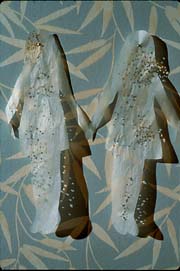|
by Kirby Gookin
Artforum, March, 2002
Lynne Yamamoto's recent exhibition, "Resplendent," immersed viewers in a pastoral tableau of cherry blossoms by the hundreds (all works 2001). At first glance the outstretched petals resembled wings, making the flowers look like butterflies--an illusion encouraged by the fact that they were pinned to the wall like insects splayed out in a natural history museum vitrine. (The allusion to methods for collecting and preserving natural specimens was strengthened by the nine large blown-glass bell jars lined up on the floor in the middle of the space, each with the stylized outline of a cherry blossom etched on its surface.) Closer inspection revealed that many of the flowers had the faces of young Asian men peering out from their tiny centers, which imbued these already ethereal forms with a spirit reminiscent of winged fairies or souls in flight. Spread densely across three walls of the gallery and thickest near the floor, the blooms created a delicate mist of pink, whose effect against the texture of the opale scent walls mimicked the sheen of silk. The installation had the uncanny appearance of a Japanese screen painting come alive.
"Resplendent" fused symbols of life, death, and rebirth into a poetic amalgam. Cherry blossoms, emblematic of spring and the brief flowering of life, have been shed from the trees; Yamamoto captures their fall. Yet she has also arrested their journey by affixing them to the wall, placing them in stasis between life and death. While the flowers (particularly those with faces) might suggest insects in flight, they can also be construed as blossoms remaining aloft on the spring breeze or even ascending toward the heavens.
The installation's success lies in the viewer's ability to access some of these subtle metaphysical sensibilities simply by looking at the work. Yet Yamamoto also offers the viewer the opportunity to go deeper into the symbolism. On the back wall of the gallery were three reproductions that provide sources for much of the Hawaii-born artist's iconography. One is a nineteenth-century woodcut depicting a royal entourage in the countryside viewing cherry blossoms, an ancient Japanese celebration of spring. In another, one found the schematic bloom from the bell jars adorning a World War II-era kamikaze fighter plane. The third reproduction shows altered pages of a book published by a small village in Japan to memorialize its young men who died in military service during the war. This book is the source for the faces in the flowers.
These elements complicate the installation's elegiac sensibility. For those who might remember Japan as an enemy, any moral high ground in the work may not be easily seen. Some viewers might be more likely to think of the September 11 suicide attacks and re-imagine the implications of the installation in this context. In fact, "Resplendent" (completed before September) is a critical examination of the cherry blossom as a wartime symbol not only of beauty and ephemerality but also death and the promise of afterlife. As Yamamoto states in a text accompanying the exhibition, "If anything, it is an ambivalent memorial."
COPYRIGHT 2002 Artforum International Magazine, Inc.

|